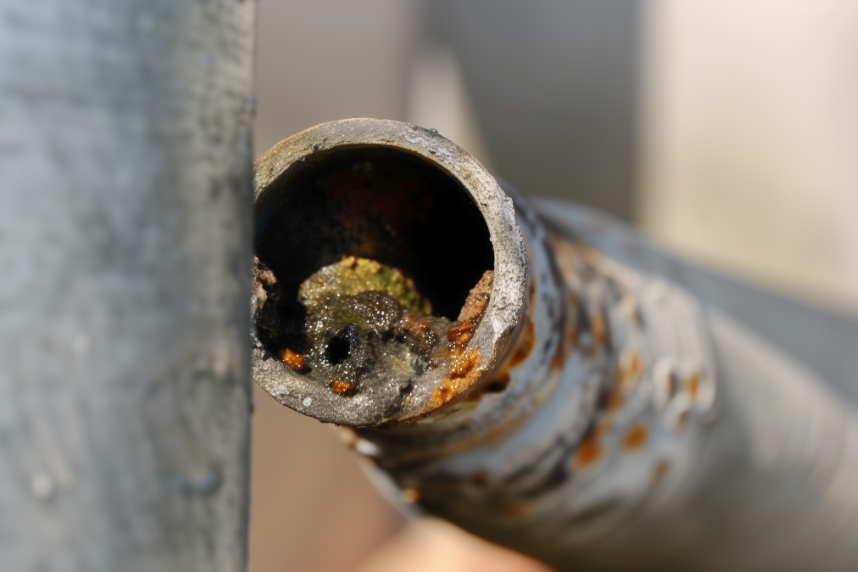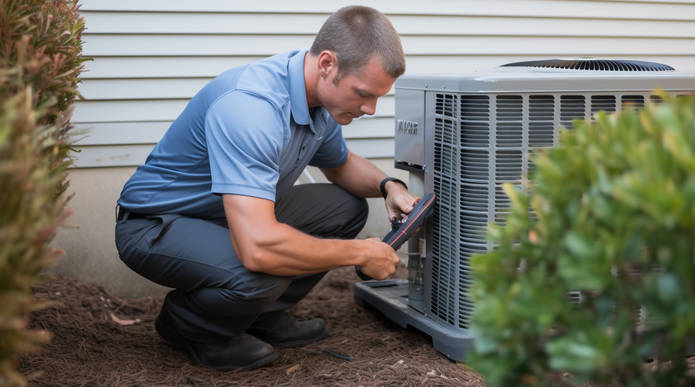Clogged AC Drain Line: Symptoms & How To Fix

Maintaining a comfortable home environment during scorching summers is essential, especially in regions like Arizona. However, a clogged AC drain line can throw a wrench into your cool comfort plans.
This article delves into the causes and consequences of clogged drain lines, providing valuable information to keep your AC system running smoothly.
We’ll explore the telltale signs of a clogged drain line so you can identify potential problems early on. We’ll also discuss professional cleaning methods and offer insights on how often to check your AC drain line for optimal performance.
Let’s get started!
| Difficulty | Time Required | Price |
| Low to medium | 1 hour | $100 to $250 |
Key Takeaways
- A buildup of dust, dirt, and mold in your AC’s drain line can disrupt cool air circulation and lead to reduced efficiency, poor indoor air quality, and even water damage.
- Signs of a clog include puddles around your AC unit, musty odors, reduced cooling efficiency, freezing of the unit, or unexpected shutdowns.
- While DIY solutions might seem tempting, professional cleaning with specialized tools and techniques ensures a safe and thorough job. This includes clearing the clog, applying antibacterial treatment, flushing the line, and testing functionality.
Why Does the AC Drain Line Get Clogged?
Ever notice your home feeling more humid than usual, even with the AC running? It might be due to a clogged drain line.
Here in Arizona and the Southwest, where we crank up the AC during scorching summers, clogged drain lines are a common hitch in our cool comfort. The culprit? A buildup of dust, dirt, and even mold.
As your AC pulls moisture from the air, it creates condensation that needs to drain away. Over time, this moisture can trap tiny particles, creating a clog that backs up the system. The result? Reduced efficiency, poor indoor air quality, and even potential water damage.
So, how can you keep your cool (literally) and avoid this AC headache? Regular maintenance, including cleaning or replacing air filters, goes a long way in preventing clogs. If you suspect a clog already, it’s best to call a qualified technician for proper diagnosis and cleaning.
AC Drain Line Clogged – Symptoms
Here are some signs that your AC drain line might be clogged:
- Puddles of water: This is the most common sign of a clogged drain line. When the drain line is clogged, the condensate pan overflows, and water leaks out of the unit. You may see puddles of water around the indoor unit or outside near the condenser unit.
- Moldy smell: The moisture from a clogged drain line can create a perfect breeding ground for mold and mildew. If you notice a musty smell coming from your AC unit or vents, it could be a sign of a clog.
- Reduced cooling efficiency: If your AC unit is not cooling your home as effectively as it used to, it could be because of a clogged drain line. A clogged drain line can restrict airflow and reduce the unit’s ability to cool the air.
- AC unit freezes up: In some cases, a clogged drain line can cause the AC unit to freeze up. This is because the cold air from the evaporator coil can’t circulate properly if the drain line is blocked.
- AC unit won’t turn on: If the drain pan overflows and the safety float switch is activated, the AC unit will shut down to prevent water damage. So, if your AC unit won’t turn on, it could be because of a clogged drain line.
If you notice any of these signs, it’s important to call a qualified HVAC technician to have your AC drain line cleaned. Early detection and treatment can help prevent more serious problems, such as water damage and mold growth.

How To Clean an AC Drain Line – Step-by-Step Guide
While tackling a DIY project is admirable, a clogged AC drain line can benefit from a professional touch. Here’s a glimpse into what you can expect when a qualified HVAC technician performs the job.
- Safety First: The technician will begin by shutting down your AC unit and ensuring electrical safety.
- Diagnosis and Inspection: They’ll then diagnose the clog by inspecting the drain line for visible blockages around the indoor unit and outdoor condenser.
- Advanced Tools: Professional technicians come equipped with specialized tools for drain line cleaning. This might include a wet/dry vacuum specifically designed for HVAC systems, which can effectively remove debris and buildup from the line.
- Clearing the Clog: The technician will then use the chosen method to clear the clog. Depending on the severity, they might use the wet/dry vacuum for simple clogs or a combination of vacuuming and cable maneuvering for tougher blockages.
- Antibacterial Treatment: After clearing the clog, the technician might use an antimicrobial solution to kill any mold or mildew growth within the drain line, preventing future blockages.
- Flushing and Testing: The technician will thoroughly flush the drain line with PVC piping cleaner or clean water to ensure proper drainage. They’ll also test the airflow and cooling efficiency of your AC unit to confirm everything is functioning optimally.
- Additional Maintenance (Optional): Depending on the condition of your system, the technician might recommend additional maintenance like cleaning the air filters or condensate pan to maximize efficiency and prevent future clogs.
| 🏡 Professional AC Maintenance
Preventative maintenance with Meadow Air keeps your AC running smoothly and efficiently. We offer comprehensive cleaning services to tackle clogged drain lines and ensure optimal airflow. Plus, our technicians are available for fast repairs if anything unexpected arises. Schedule your maintenance appointment today and breathe easy all summer long! |
How Often Should I Check the Air Conditioner Drain Line?
The frequency of checking your AC drain line depends on several factors, but it’s generally not necessary to perform a full inspection every day.
- Routine Check: It’s a good habit to visually inspect the drain line every 1-2 months, especially during peak AC usage times. Look for signs of leaks or clogs around the indoor unit and outdoor drain outlet.
- Increase Frequency for High-Risk Factors: If you have any of these factors in your home, consider checking more frequently (maybe monthly):
- Pets: Fur and dander can contribute to clogs.
- Humid Climate: More moisture in the air means more condensate to potentially clog the drain.
- Older AC Unit: As systems age, they might be more prone to clogs due to accumulated debris.
- Professional Maintenance: In addition to these checks, scheduling annual professional maintenance is recommended. A technician can thoroughly clean the drain line and perform other checks to ensure optimal AC performance and prevent future clogs.
Remember, early detection is key. By keeping an eye on your drain line and scheduling regular maintenance, you can avoid the discomfort and potential damage caused by a clogged system.
Final Thoughts
Arizona summers are no joke, and a malfunctioning AC can quickly turn your home into an uncomfortable sauna. By following the tips in this guide and understanding the importance of professional cleaning, you can ensure your AC system runs smoothly all season long.
Remember, early detection and professional intervention are key to avoiding costly repairs and maintaining optimal AC performance. At Meadow Air, our certified HVAC technicians are equipped with the expertise and tools to diagnose and clear clogged drain lines efficiently. We offer comprehensive cleaning services to keep your AC running smoothly and efficiently, preventing future problems and ensuring a cool and comfortable summer.
Don’t wait for a meltdown! Schedule your AC maintenance appointment with Meadow Air today and breathe easy all summer long. Call us now for a free quote and experience the Meadow Air difference!
FAQs
Can you clean an AC line with bleach or vinegar?
While both bleach and vinegar have some cleaning properties, we generally recommend against using them for cleaning clogged AC drain lines. Here’s why:
- Limited Effectiveness: Vinegar can be somewhat effective for minor clogs caused by mold or mildew, but it won’t break up tougher clogs caused by debris buildup. Bleach might seem stronger, but it’s not very effective for the type of clogs typically found in AC drain lines.
- Potential Damage:
- Bleach: Bleach is a harsh chemical that can corrode metal components in your AC system, especially copper piping. This can lead to leaks and expensive repairs down the line.
- Vinegar: While less harsh than bleach, concentrated vinegar can still damage certain materials used in AC drain lines, like PVC pipes.
Can you put baking soda and vinegar in the AC drain line?
No, it’s generally not recommended to put baking soda and vinegar together in your AC drain line. This method offers:
- Limited effect: While the fizzing reaction of baking soda and vinegar can be effective for some household drains, it’s not ideal for AC drain lines. These clogs are often caused by debris like mold, mildew, and sediment, which this method might not fully address.
- Potential for clogs: The reaction can create a foamy mess that might temporarily worsen the clog or even push debris further down the drain line, making professional cleaning more difficult.
- Inefficient for length: AC drain lines can be quite long, and the cleaning power of this method wouldn’t reach the entire length effectively.
